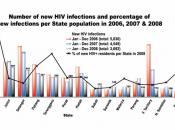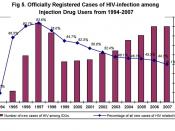August 3, 2008Aixa University of PhoenixHIV (Human Immunodeficiency Virus) is a small germ, called a virus. HIV attacks the body's immune system, which is a part of the body that fights off germs that cause infection. Overtime, HIV slowly kills the cells of the immune system: making it so weak, the body can no longer defend itself against germs. As the immune system weakens the person will become sick more often and prone to infections that are difficult to heal. AIDS (Acquired Deficiency Syndrome) develops when some one infected with HIV develops Opportunistic Infections (OIs), severe infections would not ordinarily cause disease in a person with healthy immune systems, and certain cancers. Signs of AIDS vary from person to person, and can be different among women than men. Commonly, a person who has AIDS will have infections that last a long time along with other common illnesses or they will have lost most of the immune system cells.
The first case of AIDS was reported in 1981, but the disease may have existed unrecognized for many years before that. HIV infection leading to AIDS has been a major cause of illness and death among children, teens, and young adults worldwide. AIDS has been the sixth leading cause of death in the United States among 15- to 24-year-olds since 1991. In recent years, AIDS infection rates have been increasing rapidly among teens and young adults. Half of all new HIV infections in the United States occur in people who are under 25 years old; thousands of teens acquire new HIV infections each year. Most new HIV cases in younger people are transmitted through unprotected sex; one third of these cases are from injection drug usage via the sharing of dirty, blood-contaminated needles. Among children, most cases of AIDS - and almost...


